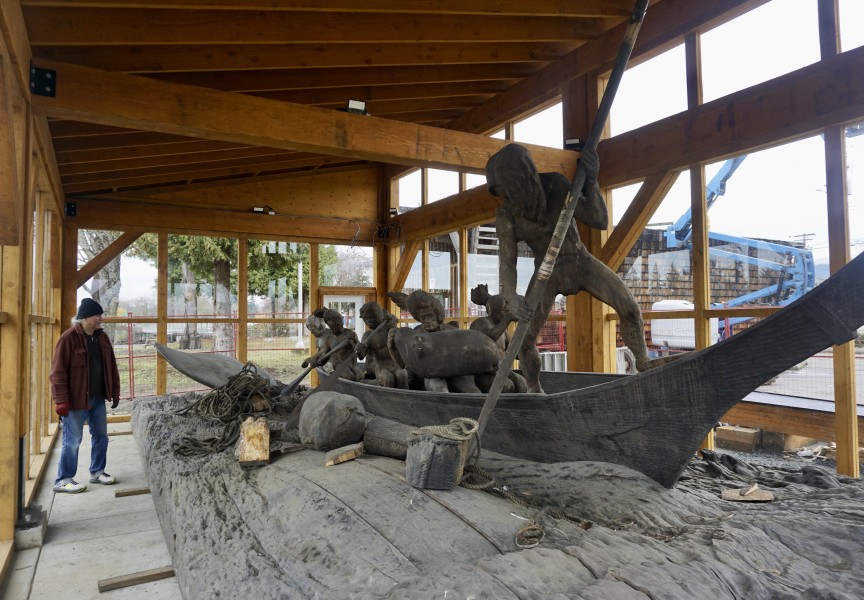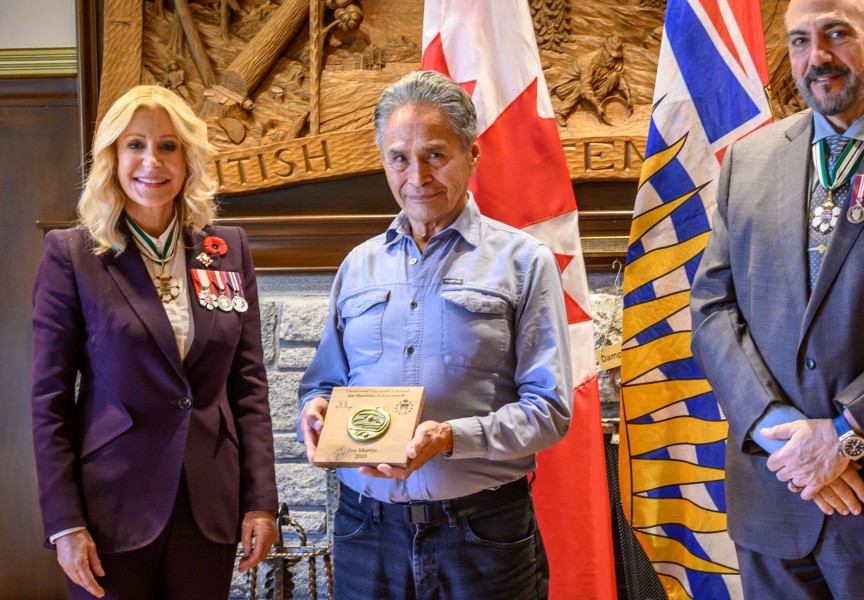Hinatinyis (Brittany Johnson) is passionate about her culture, heritage and ancestral language. The 30 year-old Huu-ay-aht woman dives deeply into her work and education with a drive that allows her very little down time; work five days a week and school on the weekends.
“I’ll rest when I’m dead,” she joked.
Hinatinyis works full-time for her nation in a mentor/apprentice language learning program. In other words, Huu-ay-aht pays her to learn their language in an immersion-style setting.
“I work with elder Angie Joe and she speaks to me only in our language,” said Hinatinyis.
From Monday to Friday Hinatinyis will drive out to Sarita where Angie lives off-grid. They may come to town or spend the day at Angie’s home.
Hinatinyis learns quickly through the immersion-style of teaching but, with English as her first language, she sometimes feels embarrassed.
“I feel like I’m talking like a baby,” she said. “I’ll be saying ‘me hungry’ or ‘we hungry’.” But Angie patiently teaches her the correct way to speak.
Hinatinyis is proud to work for her people and has dreams of helping them advance, making a better future for younger generations. She said that Huu-ay-aht administration expects their staff to look for opportunities to build on their education and advance their skills, always improving.
So when the Quuquuatsa Language Program announced that UVic was offering the course Linguistics 181: Introductory Linguistics for Language Revitalization, with a focus on Nuu-chah-nulth, Hinatinyis enrolled.
The two-year diploma program began in January 2018 and the class schedule was created with working people in mind. For that reason, the classes are held in Port Alberni on weekends.
A full week’s worth of studies and assignments are condensed into two days, making for an intense learning experience, not to mention a lack of down time for a full-time employee.
It was during one of her classes that Hinatinyis had a breakthrough in her language learning. Linguist Adam Werle instructed the class to break down Nuu-chah-nulth words into letters and sounds.
“I struggled looking at the letters and making the sounds,” she said.
It seemed like her brain was conflicted about using Nuu-chah-nulth sounds on English-looking letters.
The exercise required her to categorize the Nuu-chah-nulth alphabet into groups: one for common characters (letters) used in both languages, another for characters unique to Nuu-chah-nulth language and a third for similar letters that are pronounced differently in the Nuu-chah-nulth language.
By doing this, Hinatinyis broke through her mental block and was more easily able to speak the written words. She was inspired to create a pamphlet containing the Nuu-chah-nulth alphabet for use in the Huu-ay-aht’s daycare centre.
“I thought if it’s helpful for me it is probably helpful for others,” she said.
The pamphlet she created contains the Nuu-chah-nulth alphabet for all dialects along with instructions on how to pronounce the letters. It is designed with beginners in mind, as a first step to learning the language.
There are 47 characters in the Nuu-chah-nulth alphabet.
“It is a phonetic alphabet, which means that every letter represents a different sound, and every sound is represented by only one character,” she explained.
The best part about the teaching tool is that it is available in digital format making it adaptable to any group that needs to modify it for their purposes.
“I know there are great resources out there that do the same thing, but the books that are out there are mostly out of print, and not everyone has access to them,” said Hinatinyis. “I am all about open source learning materials and I want to create something that everyone can access.”
Building on what is currently available in language booklets and other resource material, Hinatinyis wanted to make something that is adaptable to every dialect and open to anybody wishing to learn the language.
There is an urgency to get people learning the language, said Hinatinyis. The mentor she works with is 74 years old. She said it could be as little as a decade when there are no more fluent Nuu-chah-nulth speaking elders.
The Nuu-chah-nulth Economic Development Corporation (NEDC) funded the project with contributions from the Huu-ay-aht First Nations. Hinatinyis designed the entire pamphlet in several different formats.
What is unique about this project is that Hinatinyis is making it available in a digital format so that others can download the pamphlet and modify it to better suit their particular dialect. An individual can download and print a free copy or a larger group can download a high resolution copy and have the pamphlets professionally printed.
The pamphlet will be available for download on the Huu-ay-aht website in the near future.
Always looking to practise speaking the language, Hinatinyis also does book readings. She began live streaming videos of herself reading children’s books written in Nuu-chah-nulth language.
She says she doesn’t claim to be a fluent speaker and makes no apologies for mispronunciations. It has only been a year since she began learning the Huu-ay-aht language and she is doing quite well, even though she says she sometimes sounds like a baby learning to make sentences.
This is her way of sharing her passion for learning the language and her opportunity to practise speaking.
“I appreciate NEDC for the grant to print copies for Nuu-chah-nulth nations,” she said.
Hinatinyis thanks her mentor, Angie Joe for her contributions to saving the Huu-ay-aht language.
She hopes to develop more materials like this in the future.







